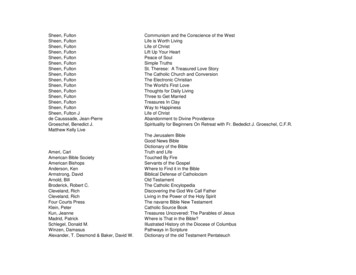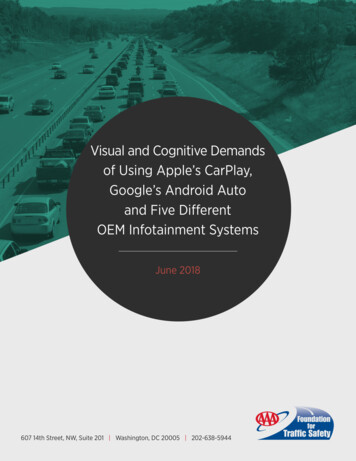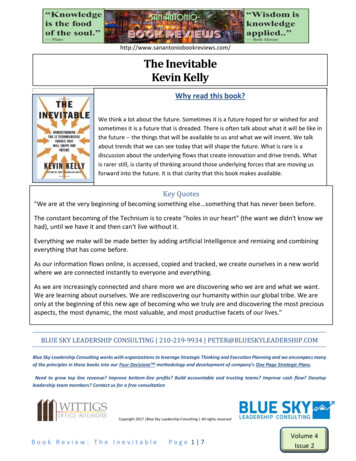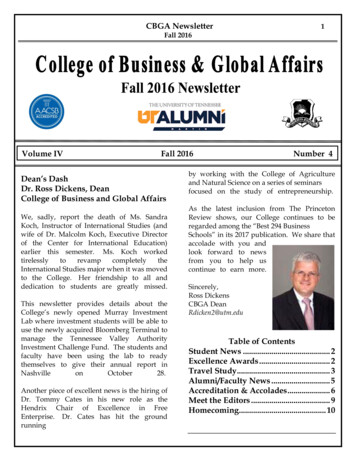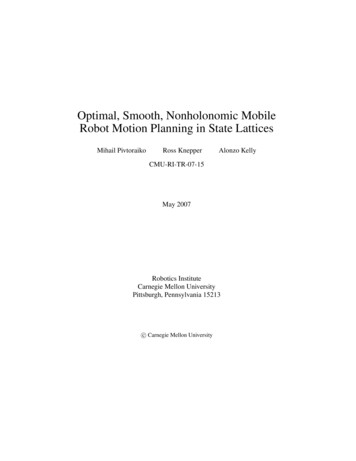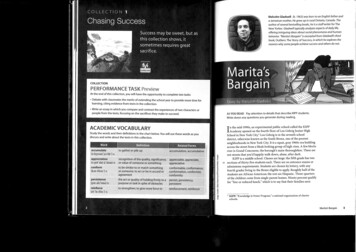
Transcription
Malcolm Gladwell (b. 1963) was born to an English father anda Jamaican mother. He grew up in rural Ontario, Canada. Theauthor of several bestselling books, he is a staff writer for TheChasing SuccessNew Yorker. Gladwell typically analyzes aspects of daily life,offering intriguing ideas about social phenomena and humanbehavior. "Marita's Bargain" is excerpted from Gladwell's thirdbook, Outliers: The Story of Success, in which he explores theSuccess may be sweet, but asthis collection shows, itsometimes requires greatsacrifice.reasons why some people achieve success and others do not.Marita'sBargainCOLLECTIONPERFOUIANICE TASK PreviewAt the end of this collection, you will have the opportunity to complete two tasks: Debate with classmates the merits of extending the school year to provide more time forTlearning, citing evidence from texts in the collection. Write an essay in which you compare and contrast the experiences of two characters orAS YOU READ Pay attention to details that describe KIPP students.Write down any questions you generate during reading.people from the texts, focusing on the sacrifices they make to succeed.ACADEMIC VOC; % , ULARYStudy the words and their definitions in the chart below. You will use these words as youdiscuss and write about the texts in this collection.Related Formsaccumulateto gather or pile upaccumulation, accumulativerecognition of the quality, significance,appreciable, appreciate,appreciative(o-kyoom'yo-lat') v.appreciation(o-pre'she-a'shon) n. or value of someone or somethingconformto be similar to or match somethingor someone; to act or be in accord oragreementconformable, conformance,conformation, conformist,conformity(par-sTs'tons) n.the act or quality of holding firmly to apurpose or task in spite of obstaclespersist, persistency,persistentreinforceto strengthen; to give more force toreinforcement, reinforcer(kon-form') v.persistenceEEn the mid-1990s, an experimental public school called the KIPPAcademy opened on the fourth floor of Lou Gehrig Junior HighSchool in New York City.' Lou Gehrig is in the seventh schooldistrict, otherwise known as the South Bronx, one of the poorestneighborhoods in New York City. It is a squat, gray 1960s-era buildingacross the street from a bleak-looking group of high-rises. A few blocksover is Grand Concourse, the borough's main thoroughfare. These arenot streets that you'd happily walk down, alone, after dark.KIPP is a middle school. Classes are large: the fifth grade has twoto sections of thirty-five students each. There are no entrance exams oradmissions requirements. Students are chosen by lottery, with anyfourth grader living in the Bronx eligible to apply. Roughly half of thestudents are African American; the rest are Hispanic. Three-quartersof the children come from single-parent homes. Ninety percent qualifyfor "free or reduced lunch," which is to say that their families earn(r6' Tn-f6rs') v.1 KIPP:"Knowledge Is Power Program," a national organization of charterschools.Marita's Bargain3
Tso little that the federal government chips in so the children can eatproperly at lunchtime.KIPP Academy seems like the kind of school in the kind ofneighborhood with the kind of student that would make educators20 despair—except that the minute you enter the building, it's clear thatsomething is different. The students walk quietly down the hallwaysin single file. In the classroom, they are taught to turn and addressanyone talking to them in a protocol known as "SSLANT": smile,sit up, listen, ask questions, nod when being spoken to, and trackwith your eyes. On the walls of the school's corridors are hundredsof pennants from the colleges that KIPP graduates have gone on toattend. Last year, hundreds of families from across the Bronx enteredthe lottery for KIPP's two fifth-grade classes. It is no exaggeration tosay that just over ten years into its existence, KIPP has become one of30 the most desirable public schools in New York City.What KIPP is most famous for is mathematics. In the SouthBronx, only about 16 percent of all middle school students areperforming at or above their grade level in math. But at KIPP, bythe end of fifth grade, many of the students call math their favoritesubject. In seventh grade, KIPP students start high school algebra. Bythe end of eighth grade, 84 percent of the students are performingat or above their grade level, which is to say that this motley groupof randomly chosen lower-income kids from dingy apartments inone of the country's worst neighborhoods—whose parents, in an40 overwhelming number of cases, never set foot in a college—do as wellin mathematics as the privileged eighth graders of America's wealthysuburbs. "Our kids' reading is on point," said David Levin, whofounded KIPP with a fellow teacher, Michael Feinberg, in 1994. "Theystruggle a little bit with writing skills. But when they leave here, theyrock in math."There are now more than fifty KIPP schools across the UnitedStates, with more on the way. The KIPP program represents one of themost promising new educational philosophies in the United States.But its success is best understood not in terms of its curriculum, itsso teachers, its resources, or some kind of institutional innovation. KIPPis, rather, an organization that has succeeded by taking the idea ofcultural legacies seriously.Just over ten years into itsexistence, KIPP has become oneof the most desirable publicschools in \ Iew York City.motley70(m6t'le) adj.unusually varied ormixed.soI604In the early nineteenth century, a group of reformers set out toestablish a system of public education in the United States. Whatpassed for public school at the time was a haphazard assortmentof locally run one-room schoolhouses and overcrowded urbanclassrooms scattered around the country. In rural areas, schools closedin the spring and fall and ran all summer long, so that children couldhelp out in the busy planting and harvesting seasons. In the city, manyschools mirrored the long and chaotic schedules of the children'sworking-class parents. The reformers wanted to make sure that allCollection 190children went to school and that public school was comprehensive,meaning that all children got enough schooling to learn how to readand write and do basic arithmetic and function as productive citizens.But as the historian Kenneth Gold has pointed out, the earlyeducational reformers were also tremendously concerned thatchildren not get too much schooling. In 1871, for example, the UScommissioner of education published a report by Edward Jarvis onthe "Relation of Education to Insanity." Jarvis had studied 1,741 casesof insanity and concluded that "over-study" was responsible for 205 ofthem. "Education lays the foundation of a large portion of the causesof mental disorder," Jarvis wrote. Similarly, the pioneer of publiceducation in Massachusetts, Horace Mann, believed that workingstudents too hard would create a "most pernicious influence uponcharacter and habits. Not infrequently is health itself destroyed byoverstimulating the mind." In the education journals of the day, therewere constant worries about overtaxing students or blunting theirnatural abilities through too much schoolwork.The reformers, Gold writes:strove for ways to reduce time spent studying, because longperiods of respite could save the mind from injury. Hence theelimination of Saturday classes, the shortening of the school day,and the lengthening of vacation—all of which occurred over thecourse of the nineteenth century. Teachers were cautioned that"when [students] are required to study, their bodies should notbe exhausted by long confinement, nor their minds bewilderedby prolonged application." Rest also presented particularopportunities for strengthening cognitive and analytical skills.As one contributor to the Massachusetts Teacher suggested, "it iswhen thus relieved from the state of tension belonging to actualstudy that boys and girls, as well as men and women, acquirethe habit of thought and reflection, and of forming their ownconclusions, independently of what they are taught and theauthority of others."cognitive(k6g1ii-tiv) adj.related to knowledgeor understanding.Marita's Bargain5
T10o110120IThis idea—that effort must be balanced by rest—could not bemore different from Asian notions about study and work, of course.But then again, the Asian worldview was shaped by the rice paddy.In the Pearl River Delta, the rice farmer planted two and sometimesthree crops a year.' The land was fallow only briefly. In fact, one ofthe singular features of rice cultivation is that because of the nutrientscarried by the water used in irrigation, the more a plot of land iscultivated, the more fertile it gets.But in Western agriculture, the opposite is true. Unless a wheator cornfield is left fallow every few years, the soil becomes exhausted.Every winter, fields are empty. The hard labor of spring plantingand fall harvesting is followed, like clockwork, by the slower paceof summer and winter. This is the logic the reformers applied to thecultivation of young minds. We formulate new ideas by analogy,working from what we know toward what we don't know, and whatthe reformers knew were the rhythms of the agricultural seasons. Amind must be cultivated. But not too much, lest it be exhausted. Andwhat was the remedy for the dangers of exhaustion? The long summervacation—a peculiar and distinctive American legacy that has hadprofound consequences for the learning patterns of the students of thepresent day.Summer vacation is a topic seldom mentioned in Americaneducational debates. It is considered a permanent and inviolate featureof school life, like high school football or the senior prom. But take alook at the following sets of elementary school test-score results, andsee if your faith in the value of long summer holidays isn't profoundlyshaken.These numbers come from research led by the Johns HopkinsUniversity sociologist Karl Alexander. Alexander tracked the progressof 650 first graders from the Baltimore public school system, lookingat how they scored on a widely used math- and reading-skills examcalled the California Achievement Test. These are reading scores forthe first five years of elementary school, broken down bysocioeconomic class—low, middle, and high.,vi 46115061534rice paddy . three crops a year: The Pearl River Delta is an area inCollection 1inviolate(In-vi e-lit) adj.secure againstchange or violation.160LowMiddleHighsoutheastern China where the Pearl River enters the South China Sea. Itcontains many rice paddies, flooded land used to grow rice.615oiLook at the first column. The students start in first grade withmeaningful, but not overwhelming, differences in their knowledge and214oability. The first graders from the wealthiest homes have a 32-pointadvantage over the first graders from the poorest homes—and by theway, first graders from poor homes in Baltimore are really poor. Nowlook at the fifth-grade column. By that point, four years later, theinitially modest gap between rich and poor has more than doubled.This "achievement gap" is a phenomenon that has been observedover and over again, and it typically provokes one of two responses.The first response is that disadvantaged kids simply don't have thesame inherent ability to learn as children from more privilegedbackgrounds. They're not as smart. The second, slightly moreoptimistic conclusion is that, in some way, our schools are failingpoor children: we simply aren't doing a good enough job of teachingthem the skills they need. But here's where Alexander's study getsinteresting, because it turns out that neither of those explanationsrings true.The city of Baltimore didn't give its kids the CaliforniaAchievement Test just at the end of every school year, in June. It gavethem the test in September too, just after summer vacation ended.What Alexander realized is that the second set of test results allowedhim to do a slightly different analysis. If he looked at the differencebetween the score a student got at the beginning of the school year,in September, and the score he or she got the following June, he couldmeasure—precisely—how much that student learned over the schoolyear. And if he looked at the difference between a student's score inJune and then in the following September, he could see how much thatstudent learned over the course of the summer. In other words, hecould figure out—at least in part—how much of the achievement gap isthe result of things that happen during the school year, and how muchit has to do with what happens during summer vacation.Let's start with the school-year gains. This table shows how manypoints students' test scores rose from the time they started classes inSeptember to the time they stopped in June. The "Total" columnrepresents their cumulative classroom learning from all five years ofelementary school.553069346039341892142823184Here is a completely different story from the one suggested by thefirst table. The first set of test results made it look like lower-incomekids were somehow failing in the classroom. But here we see plainlythat isn't true. Look at the "Total" column. Over the course of fiveyears of elementary school, poor kids "out-learn" the wealthiest kidsMarita's Bargain7
170in the United States is, on average, 180 days long. The South Korean210 school year is 220 days long. The Japanese school year is 243 days long.One of the questions asked of test takers on a recent math testgiven to students around the world was how many of the algebra,calculus, and geometry questions covered subject matter that they hadpreviously learned in class. For Japanese twelfth graders, the answerwas 92 percent. That's the value of going to school 243 days a year. Youhave the time to learn everything that needs to be learned—and youhave less time to unlearn it. For American twelfth graders, thecomparable figure was 54 percent. For its poorest students, Americadoesn't have a school problem. It has a summer vacation problem, and220 that's the problem the KIPP schools set out to solve. They decided tobring the lessons of the rice paddy to the American inner city.189 points to 184 points. They lag behind the middle-class kids by onlya modest amount, and, in fact, in one year, second grade, they learnmore than the middle- or upper-class kids.Next, let's see what happens if we look just at how reading scoreschange during summer .183.6812.3417.099.2214.51113.38152.49Do you see the difference? Look at the first column, whichmeasures what happens over the summer after first grade. Thewealthiest kids come back in September and their reading scores havejumped more than 15 points. The poorest kids come back from theholidays and their reading scores have dropped almost 4 points. Poor18o kids may out-learn rich kids during the school year. But during thesummer, they fall far behind.Now take a look at the last column, which totals up all the summergains from first grade to fifth grade. The reading scores of the poorkids go up by .26 points. When it comes to reading skills, poor kidslearn nothing when school is not in session. The reading scores of therich kids, by contrast, go up by a whopping 52.49 points. Virtually allof the advantage that wealthy students have over poor students is theresult of differences in the way privileged kids learn while they are notin school.190What Alexander's work suggests is that the way in whicheducation has been discussed in the United States is backwards.An enormous amount of time is spent talking about reducing classsize, rewriting curricula, buying every student a shiny new laptop,and increasing school funding—all of which assumes that there issomething fundamentally wrong with the job schools are doing. Butlook back at the second table, which shows what happens betweenSeptember and June. Schools work. The only problem with school, forthe kids who aren't achieving, is that there isn't enough of it.Alexander, in fact, has done a very simple calculation tozoo demonstrate what would happen if the children of Baltimore wentto school year-round. The answer is that poor kids and wealthy kidswould, by the end of elementary school, be doing math and reading atalmost the same, level.Suddenly the causes of Asian math superiority become even moreobvious. Students in Asian schools don't have long summer vacations.Why would they? Cultures that believe that the route to success liesin rising before dawn 360 days a year are scarcely going to give theirchildren three straight months off in the summer. The school year8Collection 1Image Credits: OAn drew Holbrooke/ CorbisLow"They start school at seven twenty-five," says David Levin of thestudents at the Bronx KIPP Academy. "They all do a course calledthinking skills until seven fifty-five. They do ninety minutes ofEnglish, ninety minutes of math every day, except in fifth grade, wherethey do two hours of math a day. An hour of science, an hour of socialscience, an hour of music at least twice a week, and then you have anhour and fifteen minutes of orchestra on top of that. Everyone doesorchestra. The day goes from seven twenty-five until five p.m. After230 five, there are homework clubs, detention, sports teams. There are kidshere from seven twenty-five until seven p.m. If you take an averageMarita's Bargain9
T—24025026o27010day, and you take out lunch and recess, our kids are spending fifty tosixty percent more time learning than the traditional public schoolstudent."Levin was standing in the school's main hallway. It was lunchtimeand the students were trooping by quietly in orderly lines, all of themin their KIPP Academy shirts. Levin stopped a girl whose shirttail wasout. "Do me a favor, when you get a chance," he called out, miming atucking-in movement. He continued: "Saturdays they come in nine toone. In the summer, it's eight to two." By summer, Levin was referringto the fact that KIPP students do three extra weeks of school, in July.These are, after all, precisely the kind of lower-income kids whoAlexander identified as losing ground over the long summer vacation,so ICIPP's response is simply to not have a long summer vacation."The beginning is hard," he went on. "By the end of the day they'rerestless. Part of it is endurance, part of it is motivation. Part of it isincentives and rewards and fun stuff. Part of it is good old-fashioneddiscipline. You throw all of that into the stew. We talk a lot here aboutgrit and self-control. The kids know what those words mean."Levin walked down the hall to an eighth-grade math class andstood quietly in the back. A student named Aaron was at the frontof the class, working his way through a problem from the page ofthinking-skills exercises that all KIPP students are required to do eachmorning. The teacher, a ponytailed man in his thirties named FrankCorcoran, sat in a chair to the side, only occasionally jumping in toguide the discussion. It was the kind of scene repeated every day inAmerican classrooms—with one difference. Aaron was up at the front,working on that single problem, for twenty minutes—methodically,carefully, with the participation of the class, working his way throughnot just the answer but also the question of whether there was morethan one way to get the answer."What that extra time does is allow for a more relaxedatmosphere," Corcoran said, after the class was over. "I find thatthe problem with math education is the sink-or-swim approach.Everything is rapid fire, and the kids who get it first are the ones whoare rewarded. So there comes to be a feeling that there are people whocan do math and there are people who aren't math people. I thinkthat extended amount of time gives you the chance as a teacher toexplain things, and more time for the kids to sit and digest everythingthat's going on—to review, to do things at a much slower pace. Itseems counterintuitive but we do things at a slower pace and as acounterintuitive(koun'tor-in-too iresult we get through a lot more. There's a lot more retention, bettertiv) adj. contrary tounderstanding of the material. It lets me be a little bit more relaxed.what one expects.We have time to have games. Kids can ask any questions they want,and if I'm explaining something, I don't feel pressed for time. I cango back over material and not feel time pressure." The extra timegave Corcoran the chance to make mathematics meaningful: to let hisstudents see the clear relationship between effort and reward.Collection 128o290300On the walls of the classroom were dozens of certificates from theNew York State Regents exam, testifying to first-class honors forCorcoran's students. "We had a girl in this class," Corcoran said. "Shewas a horrible math student in fifth grade. She cried every Saturdaywhen we did remedial stuff. Huge tears and tears." At the memory,Corcoran got a little emotional himself. He looked down. "She juste-mailed us a couple weeks ago. She's in college now. She's anaccounting major."The story of the miracle school that transforms losers into winnersis, of course, all too familiar. It's the stuff of inspirational books andsentimental Hollywood movies. But the reality of places like KIPP isa good deal less glamorous than that. To get a sense of what 50 to 60percent more learning time means, listen to the typical day in the lifeof a KIPP student.The student's name is Marita. She's an only child who lives in asingle-parent home. Her mother never went to college. The two ofthem share a one-bedroom apartment in the Bronx. Marita used to goto a parochial school down the street from her home, until her motherheard of KIPP. "When I was in fourth grade, me and one of my otherfriends, Tanya, we both applied to KIPP," Marita said. "I rememberMiss Owens. She interviewed me, and the way she was saying made itsound so hard I thought I was going to prison. I almost started crying.JMarita's Bargain11
the time we are finished, she is on the brink of sleeping, so that'sprobably around eleven-fifteen. Then I go to sleep, and the nextmorning we do it all over again. We are in the same room. But it'sa huge bedroom and you can split it into two, and we have beds onother sides. Me and my mom are very close.Our kids are spending fiftyto sixty percent more timelearning than the traditionalpublic school student,31032033012And she was like, If you don't want to sign this, you don't have to signthis. But then my mom was right there, so I signed it."With that, her life changed. (Keep in mind, while reading whatfollows, that Marita is twelve years old.)"I wake up at five-forty-five a.m, to get a head start," she says. "Ibrush my teeth, shower. I get some breakfast at school, if I am runninglate. Usually get yelled at because I am taking too long. I meet myfriends Diana and Steven at the bus stop, and we get the number onebus."A 5:45 wakeup is fairly typical of KIPP students, especially giventhe long bus and subway commutes that many have to get to school.Levin, at one point, went into a seventh-grade music class with seventykids in it and asked for a show of hands on when the students woke up.A handful said they woke up after six. Three quarters said they wokeup before six. And almost half said they woke up before 5:30. Oneclassmate of Marita's, a boy named Jose, said he sometimes wakes upat three or four a.m., finishes his homework from the night before, andthen "goes back to sleep for a bit."Marita went on:340350Collection 1itMarita's life is not the life of a typical twelve-year-old. Nor is it whatwe would necessarily wish for a twelve-year-old. Children, we like tobelieve, should have time to play and dream, and sleep. Marita hasresponsibilities. Her community does not give her what she needs.So what does she have to do? Give up her evenings and weekends andfriends—all the elements of her old world—and replace them withKIPP.Here is Marita again, in a passage that is little short ofheartbreaking:360I leave school at five p.m., and if I don't lollygag around, then Iwill get home around five-thirty. Then I say hi to my mom reallyquickly and start my homework. And if it's not a lot of homeworkthat day, it will take me two to three hours, and I'll be donearound nine p.m. Or if we have essays, then I will be done like tenp.m., or ten-thirty p.m.Sometimes my mom makes me break for dinner. I tell her I wantto go straight through, but she says I have to eat. So around eight,she makes me break for dinner for, like, a half hour, and then Iget back to work. Then, usually after that, my mom wants to hearabout school, but I have to make it quick because I have to getin bed by eleven p.m. So I get all my stuff ready, and then I getinto bed. I tell her all about the day and what happened, and byShe spoke in the matter-of-fact way of children who have no wayof knowing how unusual their situation is. She had the hours of alawyer trying to make partner, or of a medical resident. All that wasmissing were the dark circles under her eyes and a steaming cup ofcoffee, except that she was too young for either."Sometimes I don't go to sleep when I'm supposed to," Maritacontinued. "I go to sleep at, like, twelve o'clock, and the nextafternoon, it will hit me. And I will doze off in class. But then I haveto wake up because I have to get the information. I remember I was inone class, and I was dozing off and the teacher saw me and said, Can Italk to you after class?' And he asked me, Why were you dozing off?'And I told him I went to sleep late. And he was, like, You need to go tosleep earlier."'370Well, when we first started fifth grade, I used to have contactwith one of the girls from my old school, and whenever I leftschool on Friday, I would go to her house and stay there untilmy mom would get home from work. So I would be at her houseand I would be doing my homework. She would never have anyhomework. And she would say, "Oh, my God, you stay there late."Then she said she wanted to go to KIPP, but then she would saythat KIPP is too hard and she didn't want to do it. And I wouldsay, "Everyone says that KIPP is hard, but once you get the hangof it, it's not really that hard." She told me, "It's because you aresmart." And I said, "No, every one of us is smart." And she wasso discouraged because we stayed until five and we had a lot ofhomework, and I told her that us having a lot of homework helpsus do better in class. And she told me she didn't want to hear thewhole speech. All my friends now are from KIPP.Marita's Bargain13
Is this a lot to ask of a child? It is. But think of things fromMarita's perspective. She has made a bargain with her school. She willget up at five-forty-five in the morning, go in on Saturdays, and dohomework until eleven at night. In return, KIPP promises that it willtake kids like her who are stuck in poverty and give them a chance to380 get out. It will get 84 percent of them up to or above their grade levelin mathematics. On the strength of that performance, 90 percent ofKIPP students get scholarships to private or parochial high schoolsinstead of having to attend their own desultory high schools in theBronx. And on the strength of that high school experience, more than80 percent of KIPP graduates will go on to college, in many cases beingthe first in their family to do so.Marita doesn't need a brand-new school with acres of playingfields and gleaming facilities. She doesn't need a laptop, a smaller class,a teacher with a PhD, or a bigger apartment. She doesn't need a higher390 IQ or a mind as quick as Chris Langan's. All those things would benice, of course. But they miss the point. Marita just needed a chance.And look at the chance she was given! Someone brought a little bit ofthe rice paddy to the South Bronx and explained to her the miracle ofmeaningful work. ' COMMON R1PtnrHr,!,' Cp-, r tre4 ler ,!',,inA central idea is an important idea or message that an author wants to convey.Although a central idea may be stated, more often readers must infer it from details inthe text. Use these steps to identify the central ideas in "Marita's Bargain":desultory(des'al-tor'e) adj.lacking a fixed plan. Identify the topic of the work. The central ideas present insights or perspectiveson this subject. Gladwell's broad topic is education; more specifically, he exploresthe impact of an experimental kind of public school on students. Analyze the details used to develop the discussion. Consider the kind ofinformation these details present and how they reveal the author's view of thesubject, For example, the facts, examples, and quotations about the rigorousschedule of KIPP Academy support Gladwell's opinion about this educationalapproach. Use subheadings, the title, and other text features as clues to help identifycentral ideas. Evaluate how the organization, or structure, of the work helps develop importantideas. For example, Gladwell devotes the last two sections of his essay to Marita'sstory, suggesting that he wants to convey a specific idea about the hard work thatgoes into achieving success.COLLABORATIVE DISCUSSION Are KIPP students different from otherpublic school students? With a partner, discuss the qualities that KIPPstudents possess and how their circumstances distinguish them from otherstudents. Cite evidence from the text to support your views.CORElntegrrt- mrlr COMMON R1COREInformation can be presented in a variety of formats and media, including maps,photographs, diagrams, charts, and video. Quantitative formats, which presentnumerical or statistical data, include tables and graphs, such as line graphs, bar graphs,and circle graphs. In "Marita's Bargain," Gladwell uses several tables to support his ideas.To analyze the information in a table, follow these steps: If the table has a title, read it to see what the table is about. Gladwell's tables donot have titles, but he introduces each one in the text immediately be
book, Outliers: The Story of Success, in which he explores the reasons why some people achieve success and others do not. Chasing Success Marita's COLLECTION Bargain PERFOUIANICE TASK Preview At the end of this collect
